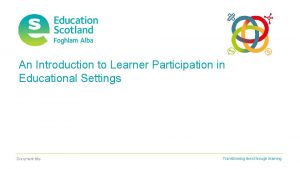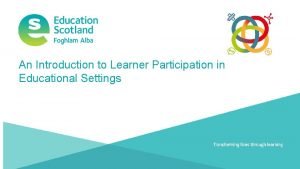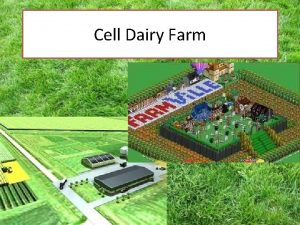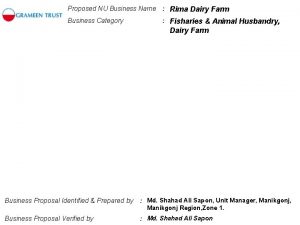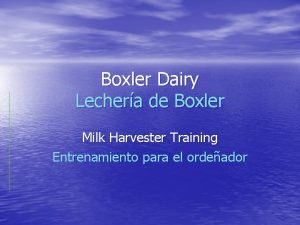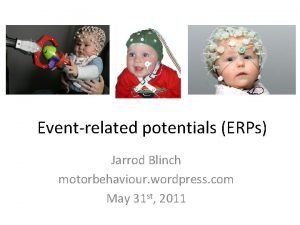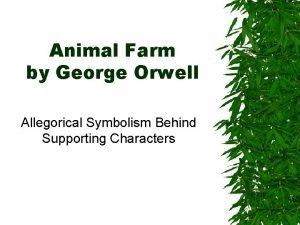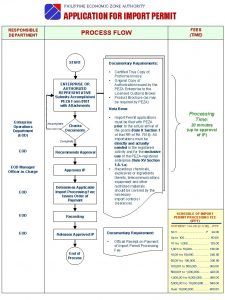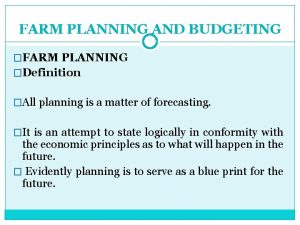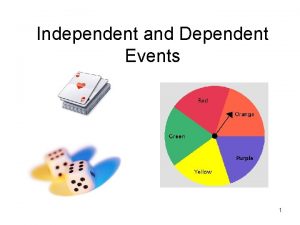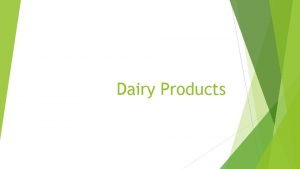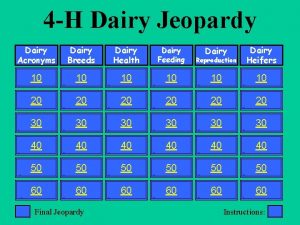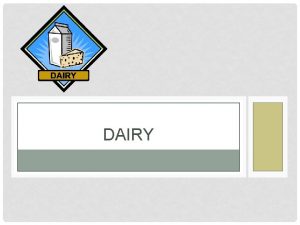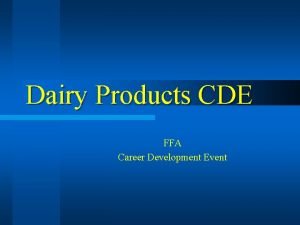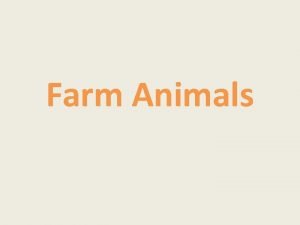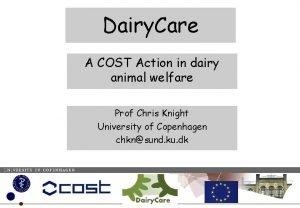Participation in an Educational Dairy Farm Event Related


















- Slides: 18

Participation in an Educational Dairy Farm Event Related to Consumers’ Motivations & Views of Dairy Production LINDSAY K. NOBBE PURDUE UNIVERSITY APRIL 14, 2011 COMMITTEE: DR. NEIL KNOBLOCH DR. MICHAEL SCHUTZ DR. COLLEEN BRADY

Introduction Dwindling Food Supply Confidence • <2% of American population actively involved in agriculture (Arkansas Foundation for Agriculture, Agricultural Educational Programs • Consumer knowledge & confidence in food products & production (MPSI, 2010 b; United Soybean Example: Dairy Industry 2006) • Questioning production practices & safety (Tucker, Whaley, Sharp, 2005; Doerfert et al. , 2005) Board, 2011) • Improve consumer diet (MPSI, 2010 b; United Soybean Board, 2011) • Inform food purchasing decisions • Brunch on the Farm • Successful based on anecdotal evidence ONLY

Purpose of the Study To explain & predict consumers’ participation in an educational dairy farm event based on: Motivations RQ 2 & 3 Views Channels RQ 1 Sources Dairy Consumption RQ 4

Conceptual Framework Brunch on the Farm Attendance Consumer Motivations Enjoyment Consumer Views of Dairy Industry Health Social Desire Competence Social Comparison (Deci & Ryan, 1991) Animal Welfare Practices Food Safety Practices Environmental Care Practices (Wimberley et al. , 2003)

Theoretical Framework Self. Determination Theory (Deci & Ryan, 1991) • Individuals are active & naturally strive for self-growth, mastery of challenges, & integration of new experiences • Focus in education, psychotherapy, work, & sports Basic Human Values Theory (Schwartz, 1996) • Values: refer to desirable goals, transform actions into situations, are the standards by which actions are determined & judged, and are prioritized • Minimal research

Review of Literature Agritourist Motivations • Experiencing agriculture, participating in adventure, relaxing, & leisure enjoyment (Carpio et al. , 2006; Miller, 2006) Environmental Care Views • Closer residents were more likely to complain (Jones et al. , n. d. ) • Water & soil contamination were greatest dairy farm complaint Animal Welfare Views Food Safety Views (Jones et al. , n. d. ) • Most research on actual animal welfare practices, not views (Center for Food Economics Research [CFER], 2001) • Animal welfare important to Indiana consumers (Truitt, 2010) • Farmers are responsible for proper treatment (Truitt, 2010) • No studies focused on dairy products • Bacterial contamination & pesticide residues were a food concern (Jones et al. , n. d. ) • Consumers want to know about practices used to produce safe food (Food Systems Insider, 2010)

Methodology DATA COLLECTION INSTRUMENT RESPONDENTS

Data Collection �Simple Random Sample (1, 201 households) N = 565 (36% response rate) � Participants (n = 48) � Non-participants (n = 154) �Geographic area (U. S. Census Bureau, 2010) Largest City Pop. = 17, 800 Smallest Town Pop. = <200 �Mail survey (Dillman, Smyth, & Christian, 2009) 4 mailings 8 weeks (Sept. -Nov. ) �Non-response error was controlled

Instrument Part 1: Motivations 2: Views 3. 1: Information Variable # of items Cronbach’s α Pilot Post-hoc Health 4 . 96 . 92 Social Desire 4 . 76 . 72 Social Comparison 4 . 89 . 75 Competence 4 . 90 Enjoyment 4 . 89 . 85 Animal Welfare Practices 6 . 77 . 68 Environmental Care Practices 7 . 83 . 77 Food Safety Practices 7 . 83 . 74 Channels Used 13 N/A never = 1 sometimes = 2 always = 3 Sources Trusted 13 N/A not at all = 1 slightly = 2 somewhat = 3 mostly = 4 always = 5 Demographics 22 N/A Multiple Used 3. 2: Information 4 Scale not at all = 1 slightly = 2 somewhat = 3 mostly = 4 always = 5 strongly disagree = 1 disagree = 2 agree = 3 strongly agree = 4

Respondents Age in Years (n =Income 194) (n = 199) Average Annual Household Gender (n = 201) 4. 1% 3. 6% 7. 4% 8. 2% 16. 7% 9. 9% 18. 6% 15. 8% Female 62% 20. 7% 34. 0% < $25, 000 - $49, 999 20 -29 $50, 000 - $74, 999 30 -39 Male - $99, 999 40 -49 38%$75, 000 31. 4% 50 -59 ≥ $100, 000 60 -69 Prefer not to answer 27. 6% 70 -79

Views of Dairy Industry Practices Conclusion 1: Similar Views of the Dairy Industry’s Animal Welfare, Environmental Care, & Food Safety Practices Food Safety p =. 01* d =. 38 Environmental Care p =. 03* d =. 38 Animal Welfare p =. 09 d =. 33 1 2 3 Nonparticipants (N = 142) Participants (N = 44) 4 Mean Scale: 1 = strongly disagree, 2 = disagree, 3 = agree, 4 = strongly agree

Motivation Conclusion 2: Participants Were Motivated to Attend Educational Dairy Farm Events Social Comparison p <. 01* d =. 52 Social Desire p <. 01* d =. 61 Competence p <. 01* d =. 62 Enjoyment p <. 01* d =. 94 Health p <. 01* d =. 54 1 2 3 4 Nonparticipants (N = 142) Participants (N = 44) 5 Mean Scale: 1 = not at all, 2 = slightly, 3 = somewhat, 4 = mostly, 5 = always

Conclusion 3: Prediction of Consumer Participation Health Ag Familiarity Animal Welfare Practices Competence Enjoyment Participation Household Consumed ≥ 3 Gallons Milk/Week 73. 0% of original grouped cases correctly classified with this model.

Conclusion 4: Differences in Food Purchasing Information Channels Consumer Use of Family of Educational &/or Friends Events as as Food Purchasing Information Channel 90. 0% 80. 0% 70. 00% 70. 0% 60. 0% 50. 0% 60. 00% 50. 00% Participants (N = 48) Nonparticipants (N (N = = 154) 40. 0% 40. 00% 30. 00% 20. 00% 10. 00% Never Sometimes Always Scale: 1 = Never, 2 = Sometimes, 3 = Always p < 05*

Implications Consumer Participation Prediction Model More Appealing Program Development & Marketing More Effective & Efficient Key Message Communication

Recommendations Alternative Data Collection Continuation of Theory Development Replication in Other Contexts

Acknowledgements COMMITTEE: DR. NEIL KNOBLOCH DR. MICHAEL SCHUTZ DR. COLLEEN BRADY SPONSORS: INDIANA SOYBEAN ALLIANCE MILK PROMOTION SERVICES OF INDIANA DEPT. OF YDAE DR. NEIL KNOBLOCH

Questions & Comments THANK YOU! Google Images
 Pengertian lrs
Pengertian lrs Learner participation in educational settings
Learner participation in educational settings Learner participation in educational settings
Learner participation in educational settings Outer fence of the plant cell
Outer fence of the plant cell Maglha nue
Maglha nue Dairy farm business names
Dairy farm business names Boxler dairy farm
Boxler dairy farm What is skill-related fitness? *
What is skill-related fitness? * 2 types of fitness
2 types of fitness Event-related potential advantages and disadvantages
Event-related potential advantages and disadvantages Harmouns
Harmouns What does benjamin represent in animal farm
What does benjamin represent in animal farm Form 8106
Form 8106 What is farm planning
What is farm planning Independent or dependent
Independent or dependent Chaernobyl
Chaernobyl Dependent events examples
Dependent events examples 5 w's event management
5 w's event management Simple and compound events examples
Simple and compound events examples

